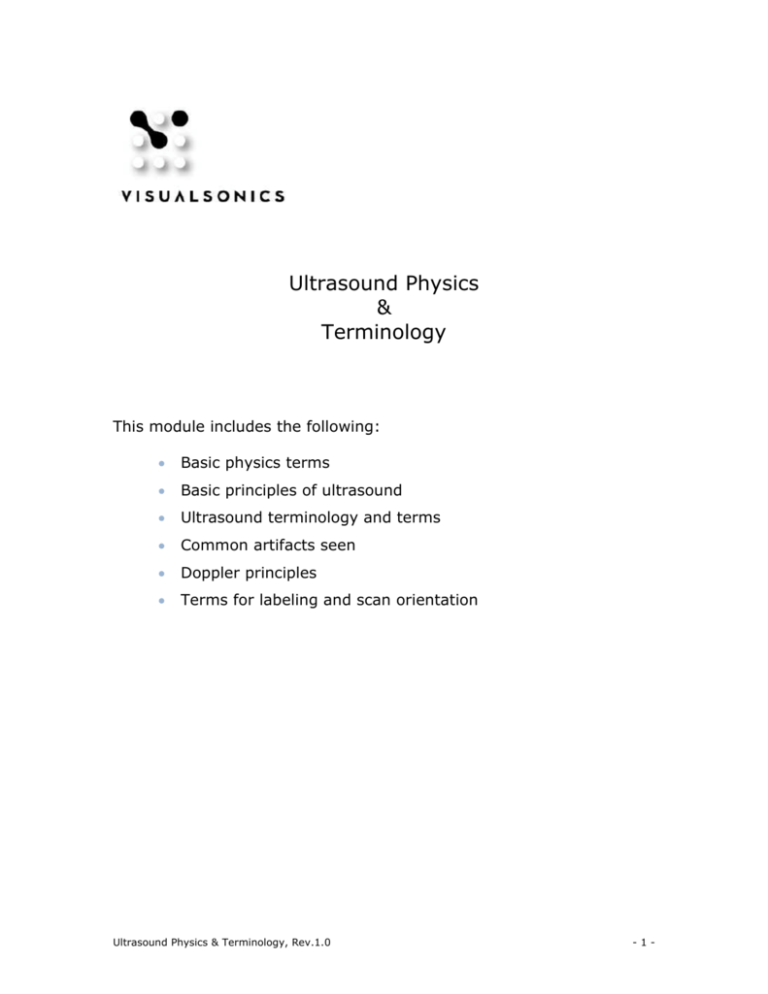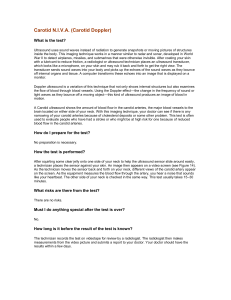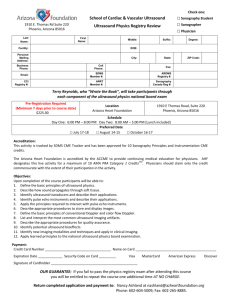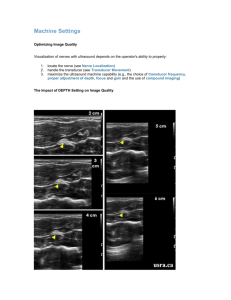Ultrasound Physics & Terminology
advertisement

Ultrasound Physics & Terminology This module includes the following: • Basic physics terms • Basic principles of ultrasound • Ultrasound terminology and terms • Common artifacts seen • Doppler principles • Terms for labeling and scan orientation Ultrasound Physics & Terminology, Rev.1.0 -1- Basic Physics Terms Ultrasound: Utilizes sound waves of very high frequency (2MHz or greater). It is propagated via waves of compression and rarefaction, and requires a medium (tissue) for travel. The higher the frequency, the less depth penetration, however the resolution is improved. Resolution: Is the parameter of an ultrasound imaging system that characterizes its ability to detect closely spaced interfaces and displays the echoes from those interfaces as distinct and separate objects. The better the resolution, the greater the clarity of an ultrasound image. Axial Is the minimum required reflector separation along the Resolution: direction of propagation required to produce separate reflections. Good axial resolution is achieved with short spatial pulse lengths. Short spatial pulse lengths are a result of higher frequency and higher damped transducers. Therefore the higher the frequency the better the resolution. Lateral Is the minimum reflector separation perpendicular to Resolution: the direction of propagation required to produce separate reflections. Good lateral resolution is achieved with narrow acoustic beams. A narrow acoustic beam is the result of a long near zone and a small angle of divergence in the far zone. Transducers: Convert one form of energy to another. Ultrasound transducers convert electric energy into ultrasound energy and vice versa. Transducers operate on piezoelectricity meaning that some Materials (ceramics, quartz) produce a voltage when deformed by an applied pressure, and reversely results in a production of pressure when these materials are deformed by an applied voltage. Pulsed Consists of one transducer element which functions as Transducers: both the source and receiving transducers. Mechanical Allows the sweeping of the ultrasound beam through Probes: the tissues rapidly and repeatedly. This is accomplished by oscillating a transducer. The oscillating component is immersed in a coupling liquid within the transducer assembly. In our case the coupling fluid is deionized water. It is important that the fluid is bubble free, so that your image is not compromised. Check the Ultrasound Physics & Terminology, Rev.1.0 -2- Attenuation: water level in the transducer assembly before scanning and if you see air bubbles, make sure you fill it with the deionized water. A decrease in amplitude and intensity, as sound travels through a medium. Attenuation occurs with absorption (conversion of sound to heat), reflection (portion of sound returned from the boundary of a medium, and scattering (diffusion or redirection of sound in several directions when encountering a particle suspension or a rough surface). These different forms of attenuation are responsible for artifacts that may be in your image. Some of these artifacts are useful and some are not. Some artifacts are produced by improper transducer location or machine settings. Basic Principles of Ultrasound Sound Waves Audible sound waves lie within the range of 20 to 20,000 Hz. Clinical ultrasound systems use transducers of between 2 and 17 MHz. The Vevo VisualSonics ultrasound system uses frequencies of between 20 to 55 MHz. Sound waves do not exist in a vacuum, and propagation in gases is poor because the molecules are too widely spaced which is why lung does not image well with ultrasound. A gel couplant is used between the skin of the subject and the transducer face otherwise the sound would not be transmitted across the air-filled gap. The strength of the returning echo is directly related to the angle at which the beam strikes the acoustic interface. The more nearly perpendicular the beam is the stronger the returning echo; smooth interfaces at right angles are known as specular reflectors. This is best seen in the walls of a large blood vessel such as the aorta or the carotid artery. Transducers Ultrasound Physics & Terminology, Rev.1.0 -3- The choice of which transducer should be used depends on the depth of the structure being imaged. The higher the frequency of the transducer crystal, the less penetration it has but the better the resolution. So if more penetration is required you need to use a lower frequency transducer with the sacrifice of some resolution. The shape of the beam is varied and is different for each transducer frequency. There is a fixed focused region of the ultrasound beam which is indicated on the system with a small triangle to the right of the image. This indicates the focal zone of that transducer and is where the best resolution can be achieved with that particular transducer. Effort should be taken to position the object of interest in the subject to within that focused area to obtain the best detail. This can be achieved with the use of more or less ultrasound gel and moving the transducer closer to or farther away from the subject. Ultrasound Terminology and Terms Anechoic: A-Mode Amplitude modulation: Attenuation: B-Mode Brightness modulation: Complex: Cystic: Enhancement (acoustic): Frequency: Gain: A structure that does not produce any internal echoes A single dimension display consisting of a horizontal baseline. This baseline represents time and or distance with upward (vertical) deflections (spikes depicting the acoustic interfaces) The ultrasound beam undergoes a progressive weakening as it penetrates the body due to absorption, scattering and beam spread. The amount of weakening is dependent on frequency, tissue density, and the number and types of interfaces A two-dimensional display of ultrasound. The Amode spikes are electronically converted into dots and displayed at the correct depth from the transducer Refers to a mass that has both fluid-filed and solid areas within it This term is used to describe any fluid-filled structure, for example, the urinary bladder Sound is not weakened (attenuated) as it passes through a fluid-filled structure and therefore the structure behind appears to have more echoes than the same tissue beside it The number of complete cycles per second (Hertz) Refers to the amount of amplification of the returning echoes Ultrasound Physics & Terminology, Rev.1.0 -4- Gel Couplant: Homogenous: Hypo-echoic: Hyper-echoic: Interface: M-Mode: Noise: Reverberation: Shadowing: Time-Gain Compensation: Transducer: Velocity (of sound): A trans-sonic material which eliminates the air interface between the transducer and the animal’s skin Of uniform appearance and texture A relative term used to describe an area that has decreased brightness of its echoes relative to an adjacent structure Also a relative term used to describe a structure which has increased brightness of its echoes relative to an adjacent structure Strong echoes that delineate the boundary of organs, caused by the difference between the acoustic impedance of the two adjacent structures; an interface that is usually more pronounced when the transducer is perpendicular to it is the motion mode displaying moving structures along a single line in the ultrasound beam An artifact that is usually due to the gain control being too high An artifact that results from a strong echo returning from a large acoustic interface to the transducer. This echo returns to the tissues again, causing additional echoes parallel and equidistant to the first echo Failure of the sound beam to pass through an object, e.g. a bone does not allow any sound to pass through it and there is only shadowing seen behind it Compensation for attenuation is accomplished by amplifying echoes in the near field slightly and progressively increasing amplification as echoes return from greater depths A device which houses the element for transmitting and receiving ultrasound waves. Also referred to as a probe or Scanhead Is the speed at which a sound wave is traveling. In soft tissue at 37 degrees C. sound travels at 1540 m/second Common Artifacts Seen Reverberation: Multiple reflections commonly seen in the bladder or heart Ultrasound Physics & Terminology, Rev.1.0 -5- Shadowing: Enhancement: Speckle: Created by strong reflectors, or attenuating structures, i.e. bone, gas, calcifications and air Increase in reflection amplitude from reflectors that lie behind a weakly attenuating structure, i.e. cysts, solid masses The granular appearance of images and spectral displays that is caused by the interference of echoes from the distribution of scatterers in tissue. Within transducers, there is a FOCUS which concentrates the sound beam into a smaller beam area than would exist otherwise. This area of focus is where you will obtain your best images. You will find the focus on the monitor (arrow), on the vertical millimeter scale. So when positioning your anatomy make sure it is in the region of the focus, so that you obtain your best images. Time Gain Compensation (TGC): Equalizes differences in received reflection amplitudes because of the reflector depth. Reflectors with equal reflector coefficients will not result in equal amplitude reflections arriving at the transducer if their travel distances are different. TGC allow you to adjust the amplitude to compensate for the path length differences. The longer the path length the higher the amplitude. The TGC is located on the right upper hand corner of the monitor, and is displayed graphically. B-MODE (brightness mode): The mode that is used for the display of echoes that return to the transducer. There is a change in spt brightness for each echo that is received by the transducer. The returning echoes are displayed on a television monitor as shades of gray. Typically the brighter gray shades represent echoes with greater intensity levels. This mode allows you to scan. Ultrasound Physics & Terminology, Rev.1.0 -6- M-MODE (motion mode): Is a graphic B-mode pattern that is a single line time display that represents the motion of structures along the ultrasound beam, 1000fps. This mode allows you to trace motion i.e. heart wall motion, vessel wall motion. PW MODE (pulsed-wave mode): Frequency change of reflected sound waves as a result of reflection motion relative to the transducer used to detect the velocity and direction of blood flow. This reflection shift can be displayed graphically, as well as audibly. During Doppler operation the reflected sound has the same frequency as the transmitted sound if the blood is stationary ( we know that blood is not stationary it moves) therefore if the blood is moving away from the transducer a lower frequency is detected (negative shift) the spectrum appears below the baseline. If the blood is moving toward the transducer a higher frequency (positive shift) is detected and the spectral displays above the baseline Doppler shift: Is dependent on the insonating frequency, the velocity of moving blood and the angle between the sound beam and direction of the moving blood. If the sound beam is perpendicular to the direction of blood flow, there will be no doppler shift therefore there would be no display of flow in the vessel. The angle of the sound beam should be less than 60 degrees at all times. Sample Volume: Is the gate length which chooses the doppler shifts that will be used to produce audible sounds or spectral display. The larger the sample volume the more Doppler frequencies detected. Aliasing: Is the production of false doppler shift and blood velocity information when the Doppler shift exceeds a threshold. It appears as if the spectral display is cut off and wraps around and reappears in the opposite region of the display. Spectral Broadening: The widening of the doppler shift spectrum. Meaning the increase of the range of doppler shift frequencies present, owing to a broader range of flow speeds encountered by the sound beam. Ultrasound Physics & Terminology, Rev.1.0 -7- Color Doppler: Doppler echoes are usually displayed with gray scale brightness corresponding to their intensities. In color doppler echoes are displayed with colors corresponding to the direction of flow that their positive or negative doppler shifts represent (toward or away from the transducer). The brightness of the color represents the intensity of the echoes, and sometimes other colors are added to indicate the extent of spectral broadening. Power Doppler: Depicts the amplitude or power of doppler signals rather than the frequency shift. This allows detection of a larger range of doppler shifts and therefore better visualization of the smaller vessels, but at the expense of directional and velocity information. DOPPLER PRINCIPLES Doppler Displays the change in frequency of a wave resulting in the motion of the wave source or reflector. In ultrasound the reflector is the moving red blood cell. The Doppler shift is dependent on the insonating frequency (transducer frequency), the velocity of the moving red blood cells, and the angle of the sound beam and direction of the moving red blood cells. The following is the Doppler equation: Df = 2f v cos q c Df = Doppler shift frequency (difference between transmitted and received) f = Transmitted frequency v = Velocity of the blood c = Speed of sound q = Angle of the sound beam and direction of moving blood cells The equation can be rearranged to detect the velocity of the blood flow with the following equation: v= Df c_ 2 f cos q Ultrasound Physics & Terminology, Rev.1.0 -8- Two important facts can be observed from this equation. First, since the cosine of 90 degrees is zero, if the ultrasound beam is perpendicular to the direction of the blood flow a Doppler shift and potentially incorrect impression of the blood flow velocities. Second, the cosine function is steeper above 60 degrees and therefore errors are magnified with insonating angles above this. Therefore, careful consideration should be taken to obtain an angle of less than 60 degrees to the direction of the blood flow to obtain reliable and accurate results in quantifying the velocity in a certain blood vessel. Power Doppler Depicts amplitude or power of the Doppler signal rather than the frequency shift. Therefore, there is less angle dependence and a visualization of smaller vessels with a Doppler shift, however, with the sacrifice of velocity and directional information. Pulsed Wave Doppler With the use of a sample gate or volume gives a graphical display of all the velocities within the area sampled. The amplitude of the signal is proportional to the number of blood cells and is indicated as a shade of gray. Ultrasound Physics & Terminology, Rev.1.0 -9- TERMS FOR LABELING AND SCAN ORIENTATION Coronal: Transverse: Sagittal (Longitudinal): Superior, Cranial, Cephalad, Rostral: Inferior or Caudal: Anterior or Ventral: Posterior or Dorsal: Medial: Lateral: Proximal: Distal: The long axis of a scan performed from the subject’s side where the slice divides the anterior from the posterior or the dorsal from the ventral in the long axis A cross-sectional view The long axis plane Interchangeable terms indicating the direction towards the head Indicating the direction towards the feet A structure lying towards the front of the subject A structure ling towards the back of the subject Towards the midline Away from the midline Towards the origin Away from the origin Ultrasound Physics & Terminology, Rev.1.0 - 10 -








![Jiye Jin-2014[1].3.17](http://s2.studylib.net/store/data/005485437_1-38483f116d2f44a767f9ba4fa894c894-300x300.png)